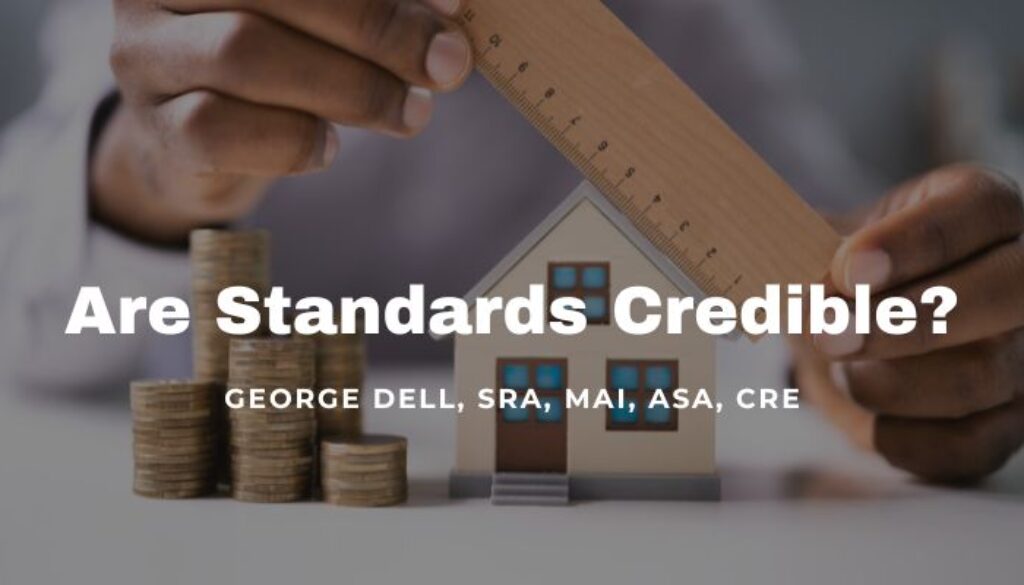“USPAP” is for credible appraisers. The underlying principle of the actual ‘standards’ and the hundreds of pages of “explanatory” material is that the appraiser’s work must be “worthy of belief.” Accuracy and precision (trueness and sureness) are never stated as a goal.
Believability, in turn, is judged by the user “expectations” and if “peers” would do it that way.
Do you suppose that if an appraiser’s work delivers what the client expects (such as a needed-value to make a loan) – then that client or client’s employee might, just might, be biased in favor of “making the deal”? That the client might find the appraiser’s opinion “worthy of belief”?
We note that one of the required elements of the appraisal-reviewer opinion is the accuracy of the original appraiser’s value opinion. But this is also based on the reviewer, not independently analyzed.
Please note — it is not possible to measure accuracy (nor the resulting opinion about accuracy), without first knowing the actual, correct, and true number. (Perhaps it is assumed that the reviewer will always have superior knowledge and competence, and thus does not need to do any actual work to show that they “know” the true value!)
This USPAP assumption seems “in-credible.” It is not worthy of belief that the reviewer’s unsupported, unstated, or obscure opinion is more valid than the analyst/appraiser’s analytic result.
Unfortunately, state boards regularly penalize appraisers’ supported opinion — based on an unsupported find-fault opinion built on disagreeing on the appraiser’s work.
Is it credible that:
- In the past five years, Standard 1 – the appraisal development standard – has had but one word changed. One word. This, in today’s world of rapid change data, discovery, and delivery.
- The only practice requirement is “[hand-picked] comparable sales data.”
- “Diligence” is the requirement to avoid significant un-worthiness.
- Carelessness or ‘gross’ negligence is not allowed.
- Assumptions must be “reasonable.”
The above are clear-cut rules, to be followed exactly, or face convicted of a ”USPAP violation.” Or are they clear cut?
Are the STANDARDS themselves credible (even using all caps!), when their whole basis is “belief”? Worthiness of belief?
Is there anything in current USPAP which is clearly defined, and usefully enforceable? Maybe.
Three specific ‘violations’ are stated in the performance standards. They comprise:
- Keep records;
- Identify the client;
- No gross negligence.
Presumably a little bit of negligence is ok.
Credible standards?
*We propose standards based on well-established data science: facts, logic, calculated uncertainty.

January 17, 2024 @ 7:32 am
George, have you used EBS in court testimony? How well does EBS present to a jury? Do you get resistance from the attorney you work with to simplify your presentation?
You criticize the reviewer a lot in your blog. Do you do reviews? How do you use EBS in your reviews?
Will your next blog present an alternative EBS USPAP?
Thanks.
January 17, 2024 @ 8:26 am
USPAP Standard 1 does recognize the need for appraisers to change and grow, utilizing new techniques as they become available.
The Comment to Standards Rule 1-1a is:
“This Standards Rule recognizes that the principle of change continues to affect the manner in which appraisers perform appraisal services.”
No specific valuation techniques are codified in USPAP.
While I agree that “worthy of belief” is not a real standard, codifying valuation techniques may not be the answer.
February 13, 2024 @ 10:36 am
Seems like circular thinking too, with too little regard for results. The point of appraisers/ appraisal is to have the last word on value, because we’re believable, because we’re appraisers… Does good math care (who)?